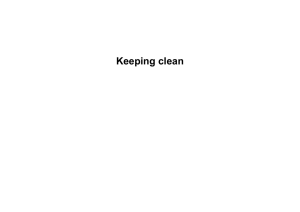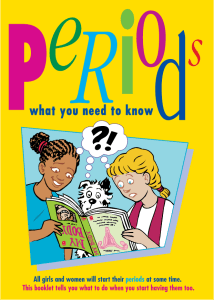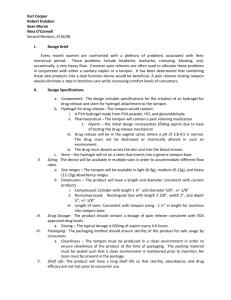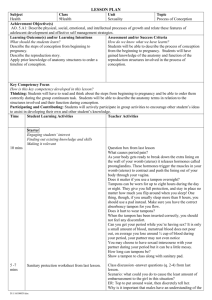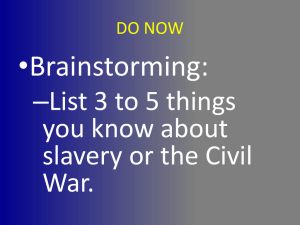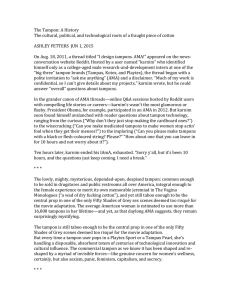Pad-making - Campus Activism
advertisement
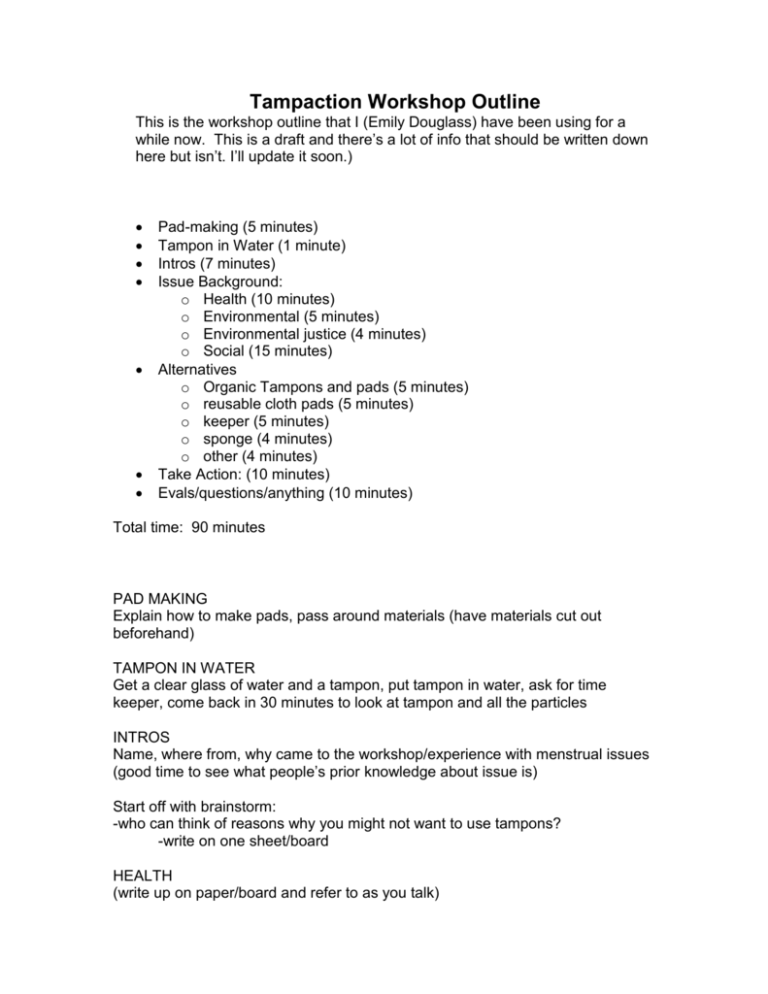
Tampaction Workshop Outline This is the workshop outline that I (Emily Douglass) have been using for a while now. This is a draft and there’s a lot of info that should be written down here but isn’t. I’ll update it soon.) Pad-making (5 minutes) Tampon in Water (1 minute) Intros (7 minutes) Issue Background: o Health (10 minutes) o Environmental (5 minutes) o Environmental justice (4 minutes) o Social (15 minutes) Alternatives o Organic Tampons and pads (5 minutes) o reusable cloth pads (5 minutes) o keeper (5 minutes) o sponge (4 minutes) o other (4 minutes) Take Action: (10 minutes) Evals/questions/anything (10 minutes) Total time: 90 minutes PAD MAKING Explain how to make pads, pass around materials (have materials cut out beforehand) TAMPON IN WATER Get a clear glass of water and a tampon, put tampon in water, ask for time keeper, come back in 30 minutes to look at tampon and all the particles INTROS Name, where from, why came to the workshop/experience with menstrual issues (good time to see what people’s prior knowledge about issue is) Start off with brainstorm: -who can think of reasons why you might not want to use tampons? -write on one sheet/board HEALTH (write up on paper/board and refer to as you talk) FDA refused to do adequate longterm testing. A lot of this stuff we just don't know. Precautionary principle 16,800 pads or tampons in life start off w/ what people say in brainstorm dioxin (is an endocrine disrupter, mimicks hormones, can cause uterine and breast cancer and anything that's tied to reproductive system. can cause endometriosis) o changed bleaching process (explain change from Chlorine Gas (which did produce dioxin to Chlorine Dioxide or Elemental Chlorine Free (which FDA says doesn’t)), doesn't produce dioxin but enters through other sources, explain levels, etc. no test guarantees no levels of dioxin tests always provided by industry bioaccumulates, most sensitive, absorbent part of body manufacturing process releases dioxins into environment which we in turn ingest, receive, leads to cancer, endometriosis rayon o what it is Artificial fibers (like rayon) used in tampons are abrasive, so when a tampon lengthens it pushes against the cervical area, causing tiny cuts and imbedding pieces into the tissue. This has been traced as the probable cause of Toxic Shock Syndrome and has been shown to damage the vaginal walls by causing ulceration and peeling of the mucous membrane. alter pH balance cause yeast infections TSS o Symptoms of TSS o Probable causes o -TSS is a rare but fatal bacterial illness that occurs mostly in young menstruators. TSS has been linked to tampon use and the high absorbency level in tampons. The number of reported cases has dropped significantly in recent years, from 55 deaths and 1,066 cases during 1979 and 1980 to 5 reported cases in 1997 and 3 in 1998, due to increased regulation by the FDA of tampon absorbancy and changes in tampon ingredients. Pesticides o 25% of all insectisides are used on cotton. o In California, it has become illegal to feed the leaves, stems, and short fibers of cotton known as gin trash to livestock, because of the concentrated levels of pesticide residue. instead, this gin trash is used to make furniture, mattresses, tampons, swabs, and cotton balls. o Five of the top nine pesticides used on cotton in the U.S. (cyanide, dicofol, naled, propargite, and trifluralin) are known cancer-causing chemicals. All nine are classified by the U.S. EPA as Category I and II-- the most dangerous. ENVIRONMENT (write up on paper and refer to) The tampon and pad manufacturing process releases dioxins and other harmful chemicals into the environment which pollute waterways and seep into the food chain. Over 12 billion pads and 7 million tampons are used once and disposed of annually, clogging our overburdened landfill sites. (National Women's Health Network) An average menstruator throws away 250 to 300 pounds of tampons, pads, and applicators in hir lifetime. The great majority of these end up in landfills or sewage treatment plants. Over 170,000 tampon applicators were collected along U.S. coastal areas between 1998 and 1999. (from the Center for Marine Conservation, info featured in E Magazine, March/April Issue 2001) Tampons are made from rayon, produced from wood pulp and cotton, a heavy pesticide crop. (25% of all insectisides are used on cotton. * In California, it has become illegal to feed the leaves, stems, and short fibers of cotton known as gin trash to livestock, because of the concentrated levels of pesticide residue. instead, this gin trash is used to make furniture, mattresses, tampons, swabs, and cotton balls. * Five of the top nine pesticides used on cotton in the U.S. (cyanide, dicofol, naled, propargite, and trifluralin) are known cancer-causing chemicals. All nine are classified by the U.S. EPA as Category I and II-- the most dangerous. ) cotton is one of the 4 crops commercially genetically engineered in the U.S. ENVIRONMENTAL JUSTICE/SEXISM Anyone familiar with the term “environmental justice”? Ask them to define Tampon corporations manufacture products and send their waste to low income, communities of color, puts disproportionate burden on them, fueled by racism and classism. Not surprising because almost all corporations do this, but important to see that the feminine hygiene industry is just as bad and contributes to environmental injustice, racism, and classism in a very direct way Environmental sexism—health problems are falling disproportionately on women and gender oppressed people because our society doesn’t care to put time and money into making sure tampons are safe, part of bigger trend of enviro sexism SOCIAL Pass ads around “Raise your hand if you’ve….” o ever hid a tampon or pad at the bottom of the garbage can o ever got embarrassed to buy menstrual products o ever bought scented product o ever not had sex because you or your partner was menstruating o ever accused of being on period when emotional o ever dreaded getting period (the hand raising survey) shows that we’re all touched by society Tampons made by men owned companies Does anyone have any stories about menstruation? Embarrassing stories, funny stories, happy stories, anything at all. We usually don’t have the space in daily lives to talk about menstruation openly so let’s make space here. ALTERNATIVES Go through each alternative. o Ask if anyone has used it before and wants to explain what it is, how it works, availability, cost. Fill in any information they missed (refer to website or Tampaction brochure for overviews of each of these). o Ask others in audience who’ve used the alternative for experiences. o Fill in pros and cons of each alternative (on website, in brochure) that people didn’t mention o o o o Organic Tampons and pads reusable cloth pads keeper sponge-Tampaction doesn’t endorse cause of all the unknown risks but we talk about it anyway cause it’s a popular alternative o other instead diaphragm divacup TAKE ACTION: o Goals: Explain bookstore goal and why o Ask for other concrete goals. o Go over campaign flowchart (have drawn up) o Pass out strategy chart and timeline, explain their usefullness, where they can get them with more explanation (our fabulous action pack!) o Campaign Chronology (i.e. week 1-research (a good time to point out other resources), find out purchasing policy, week 2 post broad support, ect). Explain terms clearly, leave room for questions about the process. Reiterate..plan plan plan.
